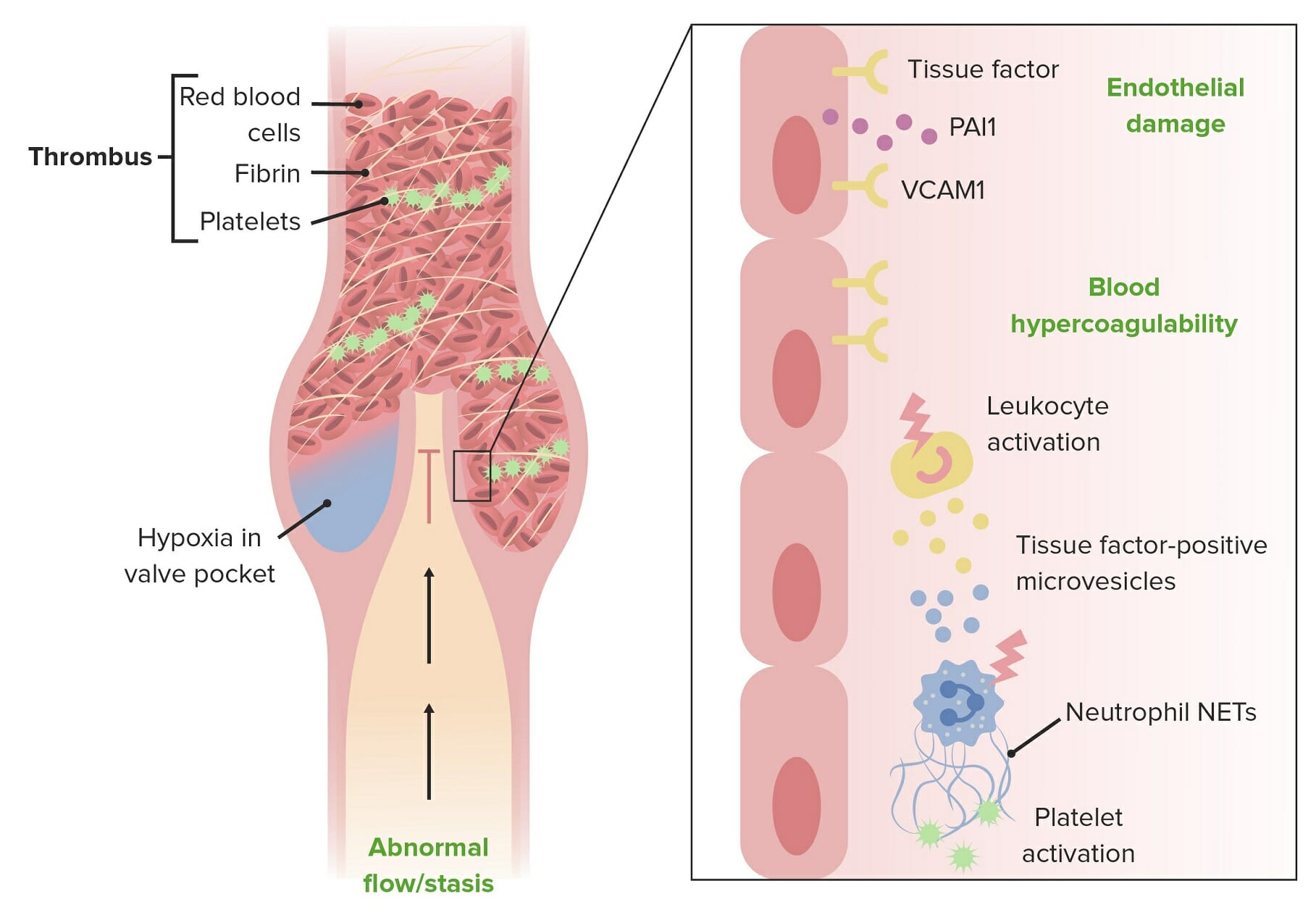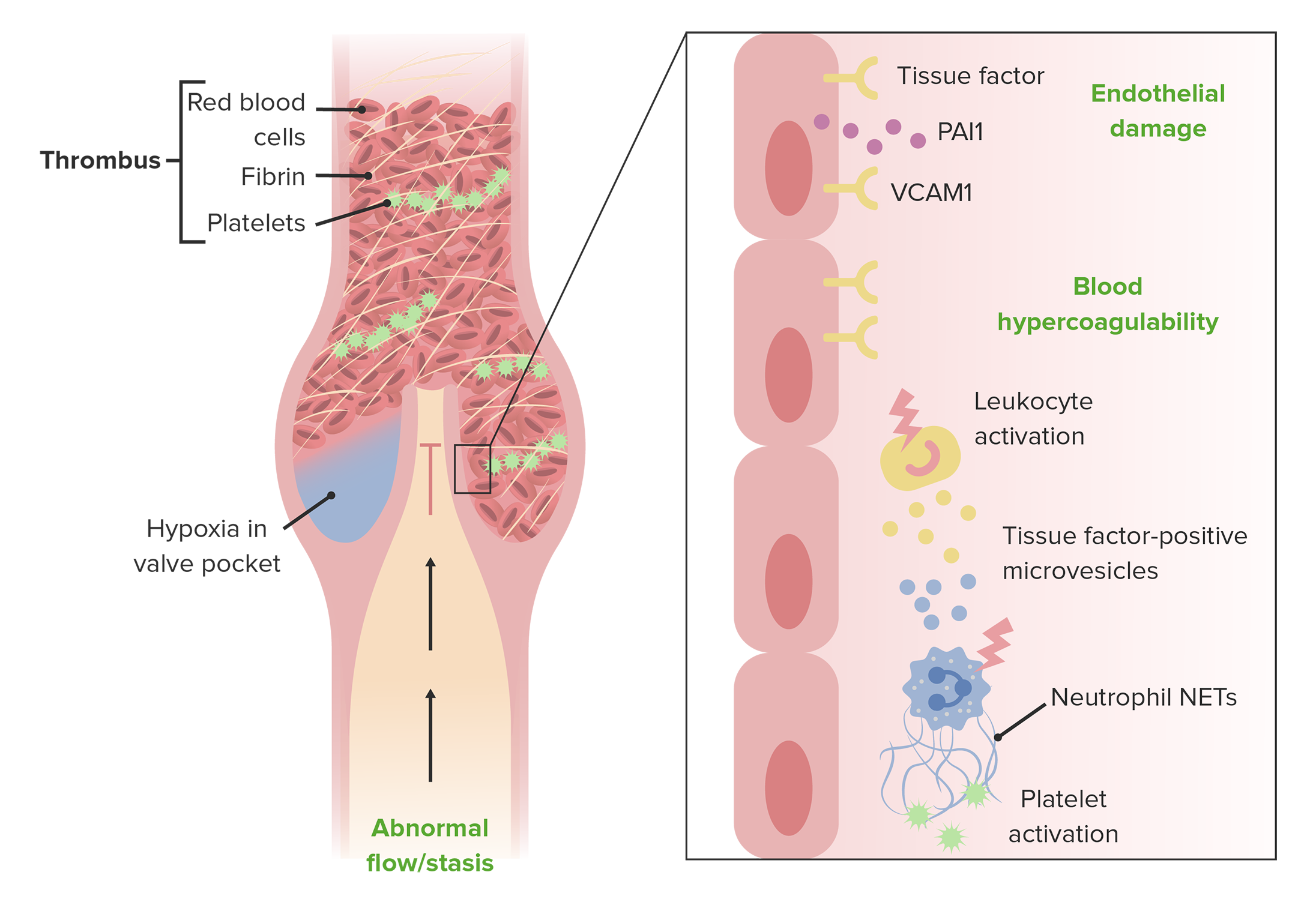Playlist
Show Playlist
Hide Playlist
Deep Vein Thrombosis: Etiology
-
Slides 10 VascularMedicine advanced.pdf
-
Reference List Vascular Medicine.pdf
-
Download Lecture Overview
00:01 What are the causes of DVT? Well, the… probably the most famous pathologist in the 19th century was Rudolf Virchow here in Germany. Virchow noted that three conditions were needed in order for blood clots to form inside a blood vessel, particularly the vein. First of all, there had to be decreased flow—stasis—such as happens, for example, from standing a long time; the blood tends to pool in the legs. The second is hypercoagulability. That is, the blood has to have a tendency to clot that's above normal. And finally, there needs to be an injury to the endothelium—to the inner lining of the vein—so that a blood clot can start to form there and propagate and get larger and eventually, of course, in a significant percentage of people, break off and embolize to the lung. 00:59 So circulatory stasis is alterations in normal blood flow with decreased flow, with a tendency of the blood flow to stay in one place. Endothelial injury or dysfunction: That can be due to trauma. It can be due to surgery, with vessel piercings or damage. And, of course, it can also be due to toxic substances—for example, things contained in cigarette smoke. Finally, hypercoagulability is an increase in the constitution of the blood so that it increases its propensity to clot. This is seen, for example, very, very strongly in patients with cancer. When patients have cancer the coagulation system is markedly activated. 01:51 Here are a number of different kinds of ways that you can have hypercoagulability. Many of these are inherited. Cancer, of course, is not an inherited one, but there are a number of inherited ones. First of all, there can be nat… the lack of a naturally occurring inhibitor of blood clotting: protein C or protein S. These prevent us from having constant clotting going on in our blood system all the time. If you're born with a decreased amount of protein C or protein S, you will have an increased tendency to clot. There are also naturally occurring abnormal coagulation factors. One of the most famous ones is called factor V Leiden, discovered by medical scientists in Leiden, Netherlands. Or there is a… an abnormal prothrombin, and each of these are factors in the clotting cascade, which is a whole series of chemical reactions that leads to a blood clot. And if one of… or more of them are abnormal, it markedly increases the tendency of spontaneous clotting. 02:56 The frequency of recurring DVT and pulmonary embolism increases by a factor of two in patients with inherited hypercoagulability states. To say it another way, if you had one of these abnormalities in the clotting system, you will have 2 chances in 100 of developing recurring DVT/PE, which is much higher than what… the 1 in 1,000 in the natural population. But most patients with these abnormalities never experience an intravascular thrombotic event, so it doesn't make sense to try and find out everybody in the society and treat them with blood thinners, because you'd have many more hemorrhages than you'd prevent DVT. So what we do is, when a patient develops DVT or pulmonary embolism, we check for a factor, because if they do have that factor, we know they have an increased risk of having the DVT / pulmonary embolism repeat, and consequently, those patients go on blood thinners for life. But most patients with these abnormalities will not have a problem.
About the Lecture
The lecture Deep Vein Thrombosis: Etiology by Joseph Alpert, MD is from the course Venous Diseases.
Included Quiz Questions
Which of the following is not part of Virchow’s triad?
- Anemia.
- Circulatory stasis.
- Endothelial dysfunction/injury.
- Hypercoagulabilty.
Which of the following is not an etiological factor involved in DVT formation?
- Hypotension.
- Stasis of blood.
- Hypercoagulability.
- Endothelial dysfunction.
Protein C is present in blood, what is its function?
- Inhibit blood clotting in the vessel.
- Signal endothelial injury to WBCs.
- Causes clot formation in cases of vessel rupture.
- Regulate laminar flow of blood.
- Remodel clot to form scar.
Customer reviews
5,0 of 5 stars
| 5 Stars |
|
5 |
| 4 Stars |
|
0 |
| 3 Stars |
|
0 |
| 2 Stars |
|
0 |
| 1 Star |
|
0 |





